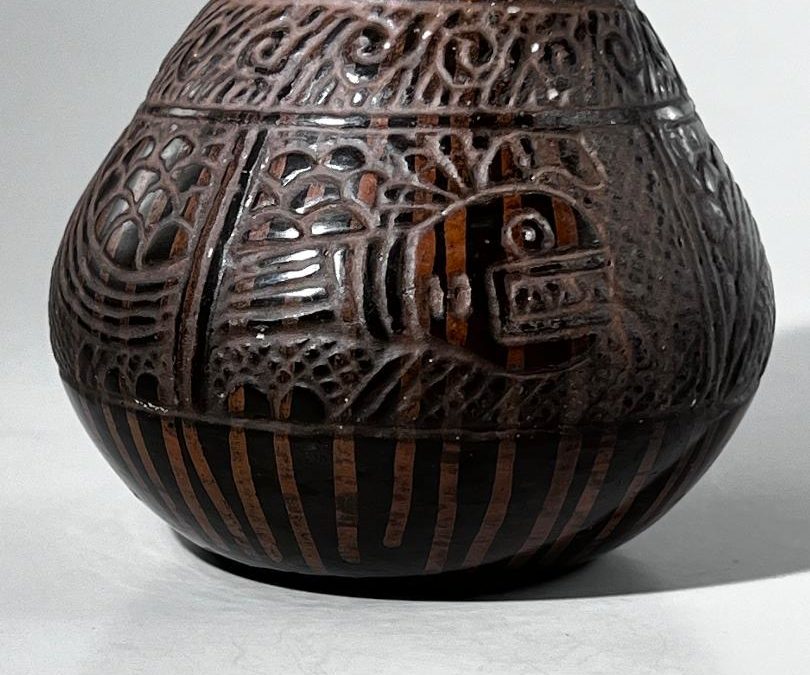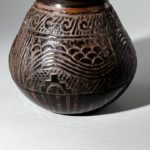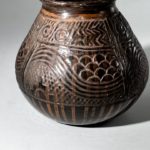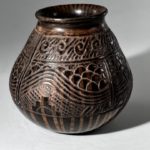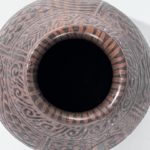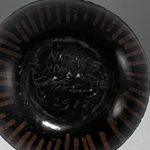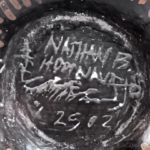This is a small but complexly-carved pot. Seen by itself, its conception and detailed execution are striking. Seen in the context of the eleven other pots by Nathan in this collection, the extraordinary range of ability of its maker is amplified.
Form:
From a 1.5-inch slightly concave base, the walls curve outwards 1.5-inches to the pot’s maximum width, and then slope 2-inches inward directly to the short neck of the jar. The neck is 0.5-inches tall and is concave with a flared lip.
The base of neck is encircled by a groove. Below is the design panel with another grove marking its lower edge. The neck —and particularly the interior lip— is highly polished, as is the 1-inch surface between lower edge of the design panel and the base of the jar.
The bottom of the jar carries the typical Nathan marks:
Nathan B
Hopi/Navajo
Cloud cypher
1-25-02
…the last line being the date the pot was fired.
Design:
This small pot carries smooth and incised surfaces, simple painted designs and complex, detailed, carved images. I’m not sure how these characteristics relate. My best guess is that the dried and smoothed pot was highly polished over its whole surface and then colored black. Forty-four vertical, parallel and Siena-brown stripes were then painted and cover all of the exterior of the jar. The shiny interior of the lip is encircled by a similar pattern: 39 short, vertical stripes of the same Siena-brown color. Perhaps the jar was then carved, then fired. All of this is supposition. I really have no idea of the sequence of events that resulted in the complex decoration on this jar. It is clear, however, that the surface of this jar was intensely manipulated using a variety of techniques and finishes.
A 2-inch-wide panel of incised design begins just below the neck of the jar and extends to just below the the jar’s waist . It contains two bands of design, a thinner band above a thicker band.
The thinner band is 7.25-inches long. The design is not continuous, but is split by a set of parallel lines (a “two-lane highway”) that extends from the wider panel below. The first inch of design to the left of this highway is filled with stacked chevron designs. The rest of this panel displays slanted, raised lines and placed equidistant in this field of lines are 14 curlicues.
The thicker band is 9.375-inches long and contains four panels depicting a one-horned serpent, from its head in panel 1 to its tail in panel 4. The panels are separated by a pattern of three vertical engraved lines, “two-lane highways.” Four other elements are used to complete the design: 1) snake-like scales, 2) crosshatching, 3) a pair of half circles, and 4) four-stepped rain clouds incorporating one half circle.
Panel 1: The serpent has a large circular head that narrows to a thick neck. The mouth is a large three-sided rectangle containing six sharp teeth and a thin extended tongue. The top of the head is graced with a forward-pointing, bent horn. Behind the horn is a fan of four feathers. The length of the body is defined by five grooves, resulting in four curved raised lanes that undulate.
The residual space, from the lower neck and the upper horn forward, is filled with crosshatching. The space behind the head above the neck carries a pattern of snake scales. Directly below the neck is more crosshatching, intruded into by a pair of half circles.
Panel 2 is transversed by the grooved body of the serpent with two undulations. Above the body the surface is filled with the snake-scale pattern. Below the body is crosshatching. On the lower right edge of the crosshatching is another pair of half circles; on the lower left edge of the crosshatching is a stylized rain cloud with 4-stepped sides and an embedded half circle..
Panel 3 has almost the same design as Panel 2, lacking only the pair of half circles: snake scales are carved above the grooved body of the serpent and crosshatching below. The 4-stepped rain cloud seen in the previous panel is also part of the design.
Panel 4 completes the serpent, the body undulating twice and ending in a pointed tail. Surrounding the body is exactly the same pattern of elements we saw in panel 2: fish scales above and crosshatching below, with the pair of half circles set on the lower right border, and the same 4-stepped rain cloud to the left.
Design analysis:
The curlicues in the upper band of design are familiar. We have seen them before, on pot 2001-04, where they were interpreted by Patterson as the ornamental locks of hair (lovelocks) worn by maidens (1994:196). I’m not convinced that all symbols have meaning, but if I were guessing, “locks of hair” would not be my first choice. Rather, I would guess that these curlicues are the shoots of new plants growing after a rain. What was in Nathan’s mind when he carved this element must be just a guess.
The small size of the pot, combined with its intricate carved design and varying surface treatments, requires a viewer to examine the pot closely. The dark color of the pot is dramatic; the serpent design is fearsome. Bands of carved design with closely-spaced elements need to be disentangled. On the polished black surfaces of the lip and lower walls of the pot, the Sienna stripes shine brightly, though when the pot is viewed at an angle, this design below the design panel is substantially hidden.
The contrast between shiny and carved surfaces adds energy to the already-dramatic design of this small jar. The Siena-brown stripes stripes underly the carved surface of the jar, but are fragmented and visually overwhelmed by the carving. These stripes have vertical energy; the serpant carving has horizontal energy. To the extent that both stripes and carving can be seen at the same time, the contradictory direction of these elements also adds tension to the design of the jar.
This small pot is a busy gem, like a carved signet of intricate design. Interestingly the two incised pots by Nathan in the collection (2013-09 and this pot) both carry the same production date: 1-25-02 and both are small and black. Carving black miniatures was apparently his creative inspiration of the day. Both of these small pots have an over-sized visual impact, but jar 2022-15 has the more intricate and engaging design. Compare this pot to the next pot purchased for the collection, also by Nathan (2022-16). The contrast of form and design could not be greater, a testimony to Nathan’s restless creative genius.

